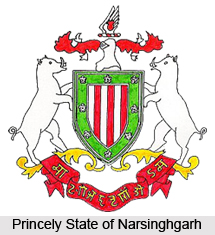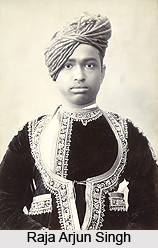 The Princely State of Narsinghgarh was one of the renowned Princely States of India during the rule of the British Empire in India. The region was under the administrative control of the Bhopal Agency, which was a subdivision of the Central India Agency. The princely state covered a total area of 1920 sqkm and comprised of a total population of 38,052 in the year 1901. The territories of the princely state are intricately linked with the Princely State of Rajgarh. Narsinghgarh state is bordered by Indore, Khilchipur and Rajgarh in north; by Bhopal and Gwalior in the south; by Dewas and Gwalior in the west; and by Bhopal and Maksundangarh (Gwalior) in the east. In the year 1941, the princely state of Narsinghgarh included 424 villages and 1 town. The capital of state was town of the same name Narsinghgarh.
The Princely State of Narsinghgarh was one of the renowned Princely States of India during the rule of the British Empire in India. The region was under the administrative control of the Bhopal Agency, which was a subdivision of the Central India Agency. The princely state covered a total area of 1920 sqkm and comprised of a total population of 38,052 in the year 1901. The territories of the princely state are intricately linked with the Princely State of Rajgarh. Narsinghgarh state is bordered by Indore, Khilchipur and Rajgarh in north; by Bhopal and Gwalior in the south; by Dewas and Gwalior in the west; and by Bhopal and Maksundangarh (Gwalior) in the east. In the year 1941, the princely state of Narsinghgarh included 424 villages and 1 town. The capital of state was town of the same name Narsinghgarh.
The Princely State of Narsinghgarh in the Malwa region of Madhya Pradesh was ruled by the Kshatriya Parmar Rajput dynasty of the Imperial Parmars of Malwa. There were four Empires of the Parmars. No one dynasty, perhaps, ever had four empires at intervals in world history. There is an old famous saying:-
"Parmara Tani Prithvi" (The Parmars rule the entire earth) or "Prithvi Tana Parmar" (The earth belongs to the Parmars).
History of Princely State of Narsinghgarh
The principality was founded in 1681 by a Hindu dynasty whose rulers belonged to the Kshatriya - Parmar clan of Rajputs and claimed descent from Umat, son of Raja Bhoj. The estate was earlier part of Rajgarh State, whose rulers also share same ancestry and from which it was carved as a new estate. The state was a feudatory Jagir to the Holkar rulers of Indore State, but in 1872 Narsinghgarh estate recognized as a state. The state was named after the deity Narsingh.
 After the nation achieved independence from the British Government of India in the year 1947, the last ruler of the princely state of Narsingarh acceded his state to the newly formed Union of India, also known as the "Dominion of India". Eventually the territory was included as a part of the new Indian state of Madhya Bharat, which later became the state of Madhya Pradesh on 1st November 1956. At present, Narsinghgarh is a town situated in the district of Damoh in Madhya Pradesh state, India.
After the nation achieved independence from the British Government of India in the year 1947, the last ruler of the princely state of Narsingarh acceded his state to the newly formed Union of India, also known as the "Dominion of India". Eventually the territory was included as a part of the new Indian state of Madhya Bharat, which later became the state of Madhya Pradesh on 1st November 1956. At present, Narsinghgarh is a town situated in the district of Damoh in Madhya Pradesh state, India.
Rulers of Princely State of Narsinghgarh
The native rulers, also known as Indian Princes, were styled as "Raja" and were entitled to a personal salute of 11 guns. The Umat Rajputs, a division of the Parmars, were the ruling family of the princely state of Narsinghgarh.
•1872 - Mar 1873 Hanwant Singh
•1873 - Apr 1890 Pratap Singh
•28 Jun 1890 - 1896 Mahtab Singh
•1896 - 22 Apr 1924 Arjun Singh
•23 Apr 1924 - 15 Aug 1947 Vikram Singh
Administration of Princely State of Narsinghgarh
The native ruler of the state was invested with full ruling powers in common revenue. He implemented final and absolute control over the administrative functions of the state. The ruler implemented full civil and criminal jurisdiction and managed the administration of the state. Narsinghgarh was divided into 4 tehsils namely Chhapera, Khujner, Pachor and Narsinghgarh. An Executive Committee was set up of 4 senior members whose decisions could have been appealed to a Council of State that was presided by the Raja.
Narsinghgarh state paid tribute to the princely state of Indore and received payments from the Puars of Dewas for the claims to the Parganas of Sarangpur and Scindia. The Bhopal Rupee was replaced by the British Rupee as legal tender in the year 1897.
Forts of Princely State of Narsinghgarh
The Fort Palace at Narsinghgarh was the official residence of the rulers built nearly 300 years ago in the Rajput style. The Fort Palace has an area of 45.323 acres. It has 304 rooms, 4 halls, 12 chowks and 64 verandas. It is situated nearly 350 feet above the town on the hood of a snake-like hill. This fort is the third biggest in the former State of Madhya Bharat, now part of Madhya Pradesh State, after the Fort of Mandu and Fort of Gwalior.






































